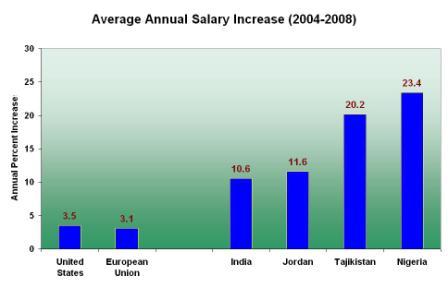 Author:
Author:
Warren Heaps – Birches Group LLC
We are all hopeful that 2010 will be a better year for business than 2009. When that hoped for upturn finally takes hold, where will your company find growth? If your company is like many others, the answer to that question points to developing markets in Africa, Asia and Latin America, where growth rates are higher and opportunities are great.
Growth is Robust
Post-recovery estimates from the IMF for 2010 indicate worldwide GDP growth of 5.7% is expected, while GDP growth in developing countries is expected to climb 9.5%.
Regional comparisons are even more dramatic:
- Sub-Saharan Africa – 9.6%
- Latin America & Caribbean – 10.5%
- Middle East – 14.9%
- Central and Eastern Europe – 1.4%
- Euro Zone – 3.6%
As you can see from these figures, growth in the developing world is expected to be almost three times greater, on average, than in the Euro Zone. Investors have already discovered this; according to Bloomberg Business Week, the top ten performing stock market indices since December 31, 1999 are all developing markets, ranging from 901% gain in Ukraine, to just 318% in Brazil. With potential like this, it’s not surprising that more and more companies are focusing on new markets in these regions.
HR Challenges
The landscape for operating in developing countries is different from what many companies may be accustomed to in Western Europe, the US and elsewhere in the developed world. For HR, the most prominent challenges are in two areas – talent and reward.
The Talent Challenge
Developing country markets are smaller than big developed country markets. Fewer employers participate in the market, and not all sectors are represented, but those that do are all vying for the same people – the best talent. Highly educated professionals are often in short supply, especially those with advanced degrees which are often obtained in the US or Europe. While professionals may have training and education in a particular occupation, it is very common for these individuals to switch occupations for advancement opportunities. They become generalists rather than specialists, and switch between sectors often as well.
Leading Employers Play a Key Role
Certain employers are found in a lot of developing countries, and help to define the labor market. These employers include companies from the banking; consumer products; oil, gas and mining; and telecom and technology sectors. Many of these companies are global multi-nationals which have been operating in developing countries for many years, and have a lot of experience with the conditions. The other major players are international public sector organizations. This group includes employers such as embassies, development banks, multi-lateral agencies such as the UN, and leading international NGOs.
Know Your Competition for Talent
Many private sector companies are surprised when we suggest they consider the international public sector as part of the group of leading employers with which they compete for talent. After all, what do oil companies or banks have to do with embassies or the World Bank? The answer is a lot!
International public sector employers are involved in a lot of the same activities as private sector companies. For example, an MBA graduate being recruited by a consumer goods company for a brand manager role is the ideal profile for an embassy public information officer. The engineers that the oil sector seeks can be deployed as project managers for infrastructure development funded by the World Bank, or an NGO such as the Global Water Project. In addition, of course, there are occupations that are common to all employers, in areas such as administration, finance, human resources, IT, etc. The lesson is to expand your focus in developing countries to include not only companies outside your sector, but some of the relevant international public sector institutions as well.
How Can I Be Competitive?
The second significant challenge for companies in developing markets is figuring out the reward structure. Compensation schemes are different in each country, but there are some common themes across developing countries which differ from more developed countries. For example, the span of salary ranges is often much wider than the typical 50% to 67% often found in developed countries. The differential from one grade to the next can vary dramatically depending on the levels — often the jump from manager to executive can be 35% or more.
Base Salary is Just the Beginning
It is quite common to provide cash allowances, such as 13th and 14th month, as well as transportation allowances or housing allowances in many countries. In addition, in-kind benefits such as beverages or meals, transportation (commuter buses) and subsidized loans are found in many markets. The value of allowances and in-kind benefits can be substantial, ranging up to 30% or more in some countries.
Good Market References Are Important
One way to ensure a competitive position in the market is to establish your position with reference to the leaders, using a high-quality compensation survey. The survey should include values for base salary, cash allowances, in-kind benefits and short-term incentives. In addition, you’ll need to be aware of the social benefits and other statutory pay practices, how pensions and insurance are provided, and how the income tax scheme influences how compensation is structured.
In Summary
Developing markets are exciting, diverse and challenging. Human resources professionals need to become aware of the unique market dynamics in smaller developing countries, including the role of leading employers and the complexities of how rewards are provided.
Note: Birches Group conducts total compensation surveys in 147 developing markets. Visit our website for more information.
More About Warren
Developing Markets Compensation and Benefits Group on LinkedIn





 Author:
Author:




You must be logged in to post a comment.